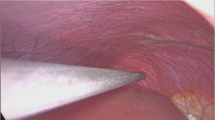Abstract
Objective
To assess the safety and cost savings of using wall suction and plastic canisters instead of evacuated bottles, currently in short supply, to drain, and collect large amounts of fluid during image-guided paracentesis procedures.
Materials and methods
In a hospital-based practice, 551 image-guided paracenteses were performed in 191 consecutive patients over a 10-month period, using wall suction to facilitate drainage. Total volume of fluid removed and complications were recorded. Complications were graded using Common Terminology Criteria for Adverse Events. The pressure generated from the wall suction at our institution was measured using a manometer and compared to that of an empty evacuated bottle. Cost savings per procedure were estimated by calculating the difference in the price of supplies used to collect the average volume of fluid removed per procedure for each method.
Results
The mean volume of fluid removed per procedure was 3541 mL. Four (0.72%) complications occurred in 551 procedures. One grade I complication consisted of a prolonged puncture site leak of ascites. Three Grade III complications included infection, hypotension, and atrial fibrillation. All four complications appeared unrelated to the use of wall suction and were treated successfully. Maximum pressure generated from the wall suction at our institution was less than the initial pressure generated from an empty evacuated bottle. Estimated cost savings per procedure was $33.92.
Conclusion
The use of wall suction and plastic canisters to drain and collect fluid during image-guided therapeutic paracenteses is a safe alternative to using evacuated glass bottles and reduces per-procedure costs.


Similar content being viewed by others
References
Moore KP, Wong F, Gines P, et al. (2003) The management of ascites in cirrhosis: report on the consensus conference of the International Ascites Club. Hepatology 38:258–266
Runyon BA, Committee APG (2009) Management of adult patients with ascites due to cirrhosis: an update. Hepatology 49:2087–2107
Grabau CM, Crago SF, Hoff LK, et al. (2004) Performance standards for therapeutic abdominal paracentesis. Hepatology 40:484–488
Gines P, Arroyo V, Quintero E, et al. (1987) Comparison of paracentesis and diuretics in the treatment of cirrhotics with tense ascites. Results of a randomized study. Gastroenterology 93:234–241
Runyon BA (1994) Care of patients with ascites. New Engl J Med 330:337–342
McGibbon A, Chen GI, Peltekian KM, van Zanten SV (2007) An evidence-based manual for abdominal paracentesis. Digest Dis Sci 52:3307–3315
Konerman MA, Price J, Torres D, Li Z (2014) Randomized, controlled pilot study comparing large-volume paracentesis using wall suction and traditional glass vacuum bottle methods. Therap Adv Gastroenterol 7:184–192
US Department of health and human services. Common Terminology Criteria for Adverse Events (CTACE) Version 4.0 http://www.evsncinihgov/ftp1/CTCAE/CTCAE_403_2010-06-14_QuickReference_5x7.pdf. 2009.
Tattersall DJ, Traill ZC, Gleeson FV (2000) Chest drains: does size matter? Clin Radiol 55:415–421
De Gottardi A, Thevenot T, Spahr L, et al. (2009) Risk of complications after abdominal paracentesis in cirrhotic patients: a prospective study. Clin Gastroenterol Hepatol 7:906–909
Runyon BA (1986) Paracentesis of ascitic fluid. A safe procedure. Arch Intern Med 146:2259–2261
Banimahd F, Spinello IM (2009) Large-volume paracentesis: a fast, convenient, and safe technique. J Emerg Med 37:409–410
Acknowledgement
The authors would like to thank Karen Munkley, R.N. for her assistance with coordinating materials and supplies for the study
Author information
Authors and Affiliations
Corresponding author
Ethics declarations
Conflict of Interest
Tatiana Kelil, MD, Paul B. Shyn, MD, Loraine E. Wu, MD, MBA, Vincent M. Levesque, MS, Daniel Kacher MS, and Stuart G Silverman, MD declare that they have no conflict of interest. Ramin Khorasani, MD, MPH, is a consultant for Medicalis Corp.
Rights and permissions
About this article
Cite this article
Kelil, T., Shyn, P.B., Wu, L.E. et al. Wall suction-assisted image-guided therapeutic paracentesis: a safe and less expensive alternative to evacuated bottles. Abdom Radiol 41, 1333–1337 (2016). https://doi.org/10.1007/s00261-016-0634-x
Published:
Issue Date:
DOI: https://doi.org/10.1007/s00261-016-0634-x




